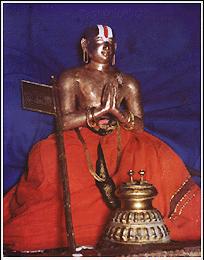About the Bhakti Discussion Group
“Bhakti is a knowledge so precious it robs everything else of interest.”
— Vedarthasangraha
Description
The Bhakti List was dedicated to discussing the religious and philosophical tradition systematized by the Indian philosopher Ramanuja (c.1017 - 1137 CE). This Web site takes its name and inspiration from this profound personality.
This mailing list was started by five of us in May of 1994, in the early days of the public internet. To my knowledge, this was the world’s first public Vedanta email discussion group. The Bhakti List quickly became popular and at its peak, had over 1500 members. However, its very popularity ensured its demise. As of this writing, the Bhakti List is no longer functioning and is unlikely to return.
Exploring Sri Ramanuja’s Philosophy
Sri Ramanuja taught that the fulfilled life was one of loving worship, service, meditation, and surrender, leading to direct experience of the Supreme Self. For Ramanuja, the seers of the Vedic tradition teach that the Supreme Self is a unitary Reality which is unfathomably profound and great, the absolutely pure seat of all knowledge and bliss, opposed to any limitation or evil of any kind and the abode of all auspiciousness. This Supreme Entity is the worshipful source and substratum of all that exists, bringing forth the universe of matter and living beings from within Itself, yet remaining within as their Inner Ruler.
Direct experience and return to this Supreme Source constitutes the supreme end of existence. To attain this Supreme Being, who is full of limitless love, grace and an infinitude of other perfections, one must be thoroughly motivated exclusively by a spirit of loving devotion. This spiritual discipline is known as bhakti, and it forms the cornerstone of Ramanuja’s exposition of Vedanta.
Ramanuja believed that his philosophy reflected the teachings of the Vedas, and he gave it no further name. However, his school was subsequently known variously as Sri Vaishnavism, Visishtadvaita, and Ubhaya Vedanta. The last expression means “Twofold Vedanta” and represents this school’s belief that the Sanskrit Vedanta of the Upanishads share meaning and purpose with the Tamil Vedanta of the Divya Prabandham, the mystic poetry of the Alvar saints. In particular, the scholars of this school have always held that both must be studied together and each must be understood in light of the other for one to truly find fulfillment in their meaning. To this day, the liturgy of all Sri Vaishnava worship includes recitation of sections from both the Veda or the Divya Prabandham, and every Sri Vaishnava scholar undertakes a thorough study of both the Sanskrit scriptures as well as the Divya Prabandham.
As with most Indian philosophies, Sri Vaishnavism is also a religious tradition, with a long and colorful intellectual, literary, and social history. Before the time of Ramanuja, who refined and formalized all aspects of the tradition, Sri Vaishnava history can be traced back through the Alvars to a Vaishnava sect known as the Pancaratras. The Alvars themselves were Pancaratra Vaishnavas, whose philosophy is first expressed in the Mahabharata. Today’s daily Sri Vaishnava religious practice is derived almost entirely from ancient Pancaratra texts, which are a mix of Vedic ritual, philosophy, meditation and yoga, and prescriptions for temple construction. Judging from their mention in early Vedantic literature and other early texts, the Pancaratra tradition can be said to be of great antiquity, with the bulk of their ideas easily traceable ultimately much further back to the Vedas themselves.
Hence, the Sri Vaishnava tradition can be traced back formally at least 1200 years and informally over two thousand years. It is not surprising that it has many formal and many more informal adherents, both here and an India. The philosophy of Visishtadvaita continues to be one of the dominant branches of Vedanta, providing guidance and spiritual solace to countless numbers of people. Visishtadvaita scholarship is active in both orthodox and research circles.

